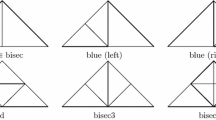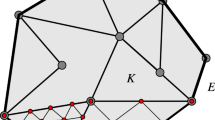Abstract
Linear reconstruction based on local cell-averaged values is the most commonly adopted technique to achieve a second-order accuracy when one uses the finite volume scheme on unstructured grids. For solutions with discontinuities appearing in such as conservation laws, a certain limiter has to be applied to the predicted gradient to prevent numerical oscillations. We propose in this paper a new formulation for linear reconstruction on unstructured grids, which integrates the prediction of the gradient and the limiter together. By solving on each cell a tiny linear programming problem without any parameters, the gradient is directly obtained which satisfies the monotonicity condition. It can be shown that the resulting numerical scheme with our new method fulfils a discrete maximum principle with fair relaxed geometric constraints on grids. Numerical results demonstrate that our method achieves satisfactory numerical accuracy with theoretical guarantee of local discrete maximum principle.
















Similar content being viewed by others
Explore related subjects
Discover the latest articles and news from researchers in related subjects, suggested using machine learning.References
van Leer, B.: Towards the ultimate conservative difference scheme. V. A second-order sequel to Godunov’s method. J. Comput. Phys. 32(1), 101–136 (1979)
Goodman, J.B., LeVeque, R.J.: On the accuracy of stable schemes for 2d scalar conversation laws. Math. Comput. 45(171), 15–21 (1985)
Spekreijse, S.: Multigrid solution of monotone second-order discretizations of hyperbolic conservation laws. Math. Comput. 49(179), 135–155 (1987)
Barth, T.J., Jespersen, D.C.: The design and application of upwind schemes on unstructured meshes. In: 27th AIAA Aerospace Sciences Meeting, vol. 366, Jan 1989
Durlofsky, L.J., Engquist, B., Osher, S.: Triangle based adaptive stencils for the solution of hyperbolic conservation laws. J. Comput. Phys. 98(1), 64–73 (1992)
Batten, P., Lambert, C., Causon, D.M.: Positively conservative high-resolution convection schemes for unstructured elements. Int. J. Numer. Methods Eng. 39(11), 1821–1838 (1996)
Liu, X.D.: A maximum principle satisfying modification of triangle based adapative stencils for the solution of scalar hyperbolic conservation laws. SIAM J. Numer. Anal. 30(3), 701–716 (1993)
Hubbard, M.E.: Multidimensional slope limiters for MUSCL-type finite volume schemes on unstructured grids. J. Comput. Phys. 155(1), 54–74 (1999)
Park, J.S., Yoon, S.H., Kim, C.: Multi-dimensional limiting process for hyperbolic conservation laws on unstructured grids. J. Comput. Phys. 229(3), 788–812 (2010)
Barth, T.J., Frederickson, P.O.: Higher order solution of the Euler equations on unstructured grids using quadratic reconstruction. In: 28th AIAA Aerospace Sciences Meeting, vol. 13, Jan 1990
Abgrall, R.: On essentially non-oscillatory schemes on unstructured meshes: analysis and implementation. J. Comput. Phys. 114(1), 45–58 (1994)
Friedrich, O.: Weighted essentially non-oscillatory schemes for the interpolation of mean values on unstructured grids. J. Comput. Phys. 144(1), 194–212 (1998)
Hu, C., Shu, C.W.: Weighted essentially non-oscillatory schemes on triangular meshes. J. Comput. Phys. 150(1), 97–127 (1999)
Liu, Y., Zhang, Y.T.: A robust reconstruction for unstructured WENO schemes. J. Sci. Comput. 54(2–3), 603–621 (2013)
Jawahar, P., Kamath, H.: A high-resolution procedure for Euler and Navier–Stokes computations on unstructured grids. J. Comput. Phys. 164(1), 165–203 (2000)
Li, W., Ren, Y.X., Lei, G., Luo, H.: The multi-dimensional limiters for solving hyperbolic conservation laws on unstructured grids. J. Comput. Phys. 230(21), 7775–7795 (2011)
Berger, M., Aftosmis, M.J., Murman, S.M.: Analysis of slope limiters on irregular grids. In: 43rd AIAA Aerospace Sciences Meeting, vol. 490, May 2005
Buffard, T., Clain, S.: Monoslope and multislope MUSCL methods for unstructured meshes. J. Comput. Phys. 229(10), 3745–3776 (2010)
May, S., Berger, M.: Two-dimensional slope limiters for finite volume schemes on non-coordinate-aligned meshes. SIAM J. Sci. Comput. 35(5), A2163–A2187 (2013)
Shu, C.W., Osher, S.: Efficient implementation of essentially non-oscillatory shock-capturing schemes. J. Comput. Phys. 77(2), 439–471 (1988)
Barth, T.J., Ohlberger, M.: Finite volume methods: foundation and analysis. In: Encyclopedia of Computational Mechanics. Citeseer, (2004)
LeVeque, R.J.: High-resolution conservative algorithms for advection in incompressible flow. SIAM J. Numer. Anal. 33(2), 627–665 (1996)
Woodward, P., Colella, P.: The numerical simulation of two-dimensional fluid flow with strong shocks. J. Comput. Phys. 54(1), 115–173 (1984)
Acknowledgments
The authors appreciate the financial supports provided by the National Natural Science Foundation of China (Grant Numbers 91330205 and 11325102).
Author information
Authors and Affiliations
Corresponding author
Appendix: All-Inequality Simplex Method
Appendix: All-Inequality Simplex Method
Consider a general LP problem in the all-equality form (20). The Lagrangian of (20) is
and the dual problem of (20) is
By the weak duality theorem, one knows that if \({{\varvec{x}}}\) is feasible for (20) and \(\varvec{\lambda }\) is feasible for (39), then
Moreover, \({{\varvec{x}}}\) is optimal for (20) provided that the equality above holds. Now we start from a vertex, and go from vertex to vertex until this equality holds. The iteration takes the form
where the step length \(\alpha \) and the searching direction \({{\varvec{p}}}\) need to be determined at each step.
Denote by \({{\varvec{a}}}_i^\top \) the i-th row of \({{\varvec{A}}}\). The active matrix \({{\varvec{M}}}\) consists of d rows of the matrix \({{\varvec{A}}}\), indicating that corresponding constraints at the current searching point \({{\varvec{x}}}\) are active. The active matrix \({{\varvec{M}}}\) needs to be non-singular.
Suppose that at a given step the active Lagrange multipliers \(\tilde{\varvec{\lambda }}\) satisfy
then \({{\varvec{c}}}^\top {{\varvec{x}}}={{\varvec{b}}}^\top \varvec{\lambda }\) with all the inactive Lagrange multipliers vanishing, and we end up with an optimal point \({{\varvec{x}}}\). Otherwise, we remove the constraint j such that the component \(\lambda _j<0\) and determine the searching direction \({\varvec{p}}\) through
where \({{\varvec{e}}}_j\) is the j-th coordinate vector.
Assuming that the point in the next step \({{\varvec{x}}}+\alpha _i{{\varvec{p}}}\) satisfies the constraint i, then we have
which yields the step length with regard to i to be
Since \(b_i-{{\varvec{a}}}_i^\top {{\varvec{x}}}\ge 0\), it suffices to consider those constraints satisfying \({{\varvec{a}}}_i^\top {{\varvec{p}}}>0\). The actual step length \(\alpha \) is then taken as the minimum of all the estimated step lengths
Finally we choose an index k satisfying \(\alpha _k=\alpha \) and update the active matrix by replacing j-th row of \({{\varvec{M}}}\) with k-th row of \({{\varvec{A}}}\). So far we finish one loop. The whole algorithm is illustrated in Algorithm 1. Note that we use the negation of both the searching direction \({{\varvec{p}}}\) and step length \(\alpha \).

Rights and permissions
About this article
Cite this article
Chen, L., Li, R. An Integrated Linear Reconstruction for Finite Volume Scheme on Unstructured Grids. J Sci Comput 68, 1172–1197 (2016). https://doi.org/10.1007/s10915-016-0173-1
Received:
Revised:
Accepted:
Published:
Issue Date:
DOI: https://doi.org/10.1007/s10915-016-0173-1




